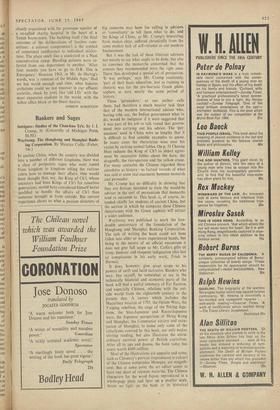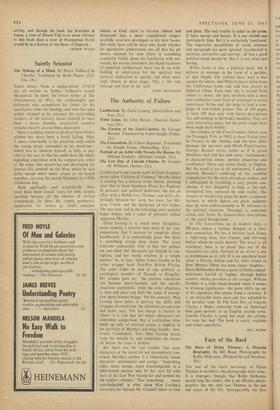Bankers and Sages
• 70s.)
IN ancient China, when the country was divided into a number of different kingdoms, there was a class of peripatetic sages who went round from kingdom to kingdom telling the various rulers how to manage their affairs. One would have thought that, say, the King of Ch'i, whose ancestors had been Kings of Ch'i for countless generations, would have considered himself better qualified to handle the affairs of Ch'i than someone brought in from outside. But current experience shows us what a passion directors of
big concerns may have for calling in advisers or 'consultants' to tell them what to do, and the Kings of China, as Mr. Crump's interesting book makes clear, suffered chronically from the same modest lack of self-reliance as our modern businessmen.
But it was the task of these itinerant advisers not merely to say what ought to be done, but also to convince the monarchs concerned that the courses they recommended were the right ones. There thus developed a special art of persuasion. 'It was perhaps,' says Mr. Crump cautiously, `part of their basic education, just as training in rhetoric was for the pre-Socratic Greek philo- sophers at very nearly the same period of history.'
These 'persuaders,' as our author calls them, had therefore a much heavier task than that of the modern international adviser who, having told, say, the Indian government what to do, would be indignant if it were suggested that it was part of his job to talk round that govern- ment into carrying out his advice. The 'per- suasions' used in China were so lengthy that it is difficult to find suitable examples to quote. In many cases the rhetorician wins over his victim by reciting animal fables. On p. 51 Chuang Hsin reduces the King of Ch'i to abject agree- ment by successive fables about the hare, the dragonfly, the rice-sparrow and the yellow crane. For many centuries the Chinese regarded these anecdotes as history—as factual records of what was said at some real encounter between monarch • and persuader.
Mr. Crump has no difficulty in showing that they are fictions intended to train the would-be adviser in the sort of persuasions that monarchs tend to succumb to. This book is, of course, in- tended chiefly for students of ancient China, but the section in which he compares these Chinese rhetoricians with the Greek sophists will attract a wider audience.
Wayfoong was published to mark the hun- dredth anniversary of the foundation of the Hongkong and Shanghai Banking Corporation. The task of writing the book could not have fallen into abler or more experienced hands, but being in the nattire of an official encomium it does not give full scope to Mr. Collis's gifts of irony, humour and eloquent indignation (this last so conspicuous in his early work, Trials in Burma).
It does, however, give great scope to his powers of swift and lucid narrative. Readers who may, like myself, be somewhat at sea in the technically financial and economic parts of the book will find a useful summary of Far Eastern, and especially Chinese, relations with the out- side world from the eighteenth century to the present day. A survey which includes the Macartney mission of 1793, the Opium Wars, the T'aiping rebellion, the siege of the Peking lega- tions, the Sino-Japanese and Russo-Japanese wars, the Japanese occupations of Hong Kong and Shanghai, the Communist victory and occu- pation of Shanghai, to name only some of the cataclysms covered by this book, not only makes stirring reading, but also illustrates the extra- ordinary survival power of British capitalism. After all its ups and downs, the bank today has assets worth £600 million.
Most of the illustrations are apposite and some, such as Chinnery's portrait (reproduced in colour) of the Chinese comprador Howqua, are magnifi- cent. But at some point the art editor seems to have run short of relevant material. The Chinese characters for the word Japan, reproduced in a whole-page plate and later on a smaller scale, throw no light on the bank or its historical setting, and though the bank has branches in Japan, a view of Mount Fuji is no more relevant in this book than a view of Hampstead Heath would be in a history of the Bank of England.
ARTHUR WALEY







































 Previous page
Previous page